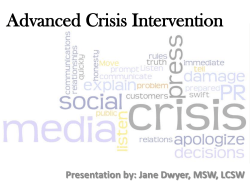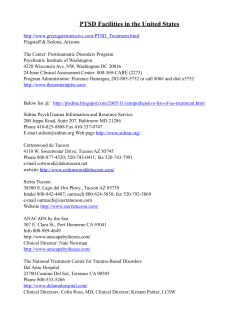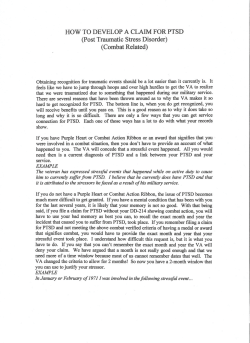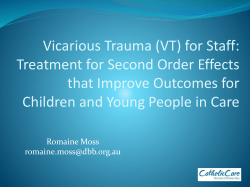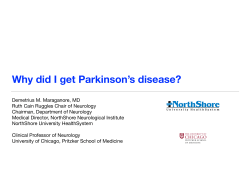
Document 67776
Children’s Mental Health Fact Sheet for the Classroom Post-Traumatic Stress Disorder About the Disorder Children who are involved in or witness to a traumatic event that involved intense fear, helplessness, or horror are at risk for developing posttraumatic stress disorder (PTSD). The event is usually a situation where someone’s life has been threatened or severe injury has occurred such as serious accidents, abuse, violence, or natural disasters. In some cases, the “event” may be a re-occurring trauma, such as continuing domestic violence. SYMPTOMS OR BEHAVIORS •Flashbacks, hallucinations, nightmares, recollections, reenactment, or repetitive play referencing the event •Emotional distress from reminders of the event •Physical reactions from reminders of the event, including headache, stomachache, dizziness, or discomfort in another part of the body •Fear of certain places, things, or situations that remind them of the event •Denial of the event or inability to recall an important aspect of it •A sense of a foreshortened future •Difficulty concentrating and easily startled After the event, children may initially be agitated or confused. Eventually this develops into denial, fear, and even anger. They may withdraw and become unresponsive, detached, and depressed. Often they become emotionally numb, especially if they have been subjected to repeated trauma. They may lose interest in things they used to enjoy. Students with PTSD often have persistent frightening thoughts and memories of the experience. They may re-experience the trauma through flashbacks or nightmares. These occur particularly on the anniversary of the event, or when a child is reminded of it by an object, place, or situation. During a flashback, the child may actually lose touch with reality and re-enact the event. PTSD is only diagnosed if the symptoms last more than one month. Symptoms usually begin within three months of the trauma, but occasionally not until years after; they may last from a few months to years. Early intervention is essential, ideally immediately following the trauma. If the trauma is not known, then treatment should begin when symptoms of PTSD are first noticed. Some studies show that when children receive treatment soon after a trauma, symptoms of PTSD are reduced. A combination of treatment approaches is often used for PTSD. Support from family, school, friends, and peers can be an important part of recovery for children with PTSD. With sensitivity, support, and help from mental health professionals, children can learn to cope with their trauma and go on to lead a healthy and productive life. •Self-destructive behavior, irritability, and impulsiveness, or anger and hostility •Depression and overwhelming sadness or hopelessness Minnesota Association for Children’s Mental Health • 1.800.528.4511 165 Western Ave, Suite 2, St. Paul, MN 55102 • www.macmh.org Children’s Mental Health Fact Sheet for the Classroom Post-Traumatic Stress Disorder EDUCATIONAL IMPLICATIONS The severity and persistence of symptoms vary greatly among children affected by PTSD. Their symptoms may come and go for no apparent reason, and their mood may change drastically. Children with PTSD will often regress. They may act younger than their age, which can result in increased emotional and behavioral problems. They may become clingy, whiny, impatient, impulsive, and/or aggressive. They may be unable to perform previously acquired skills, even basic functions like speech. Their capacity for learning may be decreased. They often have difficulty concentrating, are preoccupied, and become easily confused. They may lose interest in activities, become quiet and/or sad, and avoid interaction with other children. Instructional Strategies and Classroom Accommodations • Try to establish a feeling of safety and acceptance within the classroom. Greet the child warmly each day, make eye contact, and let the child know that he/she is valued, and that you care. • Don’t hesitate to interrupt activities and avoid circumstances that are upsetting or re-traumatizing for the child. • Provide a consistent, predictable routine through each day as much as possible. If the schedule does change, try to explain beforehand what will be different and why. • Consistency shows children that you have control of the situation. However, allow children choices within this pattern wherever possible. • Try to eliminate stressful situations from your classroom and routines: make sure your room arrangement is simple and easy to move through; create a balance of noisy versus quiet activity areas, and clearly define them; plan your day or class period so that it alternates between active and quiet activities. • Make yourself available and open to listening, remembering to always respect the child’s need for confidentiality. • Do not tell a child “to forget” about the incident. • Reassure children that their symptoms and behaviors are a common response to a trauma and they are not “crazy” or bad. • Incorporate large muscle activities into the day. Short breaks involving simple exercises can help relieve anxiety and restlessness. For additional suggestions on classroom strategies and modifications see “A Teacher’s Guide to Children’s Mental Health” available from MACMH. RESOURCES Anxiety Disorders Association of America (ADAA) 8730 Georgia Av, Ste 600 Silver Spring, MD 20910 240-485-1001 www.adaa.org International Society for Traumatic Stress Studies 60 Revere Drive, Ste 500 Northbrook, IL 60062 847-480-9028 www.istss.org Sidran Traumatic Stress Institute 200 E. Joppa Rd, Ste 207 Towson, MD 21286 410-825-8888 www.sidran.org National Center for PTSD VA Medical Center (116D) 215 N Main St White River Junction, VT 05009 802-296-5132 www.ncptsd.org Links to interdisciplinary index database, publications, books, research quarterly, clinical quarterly, assessment instruments PTSD Alliance www.ptsdalliance.org Minnesota Association for Children’s Mental Health • 1.800.528.4511 165 Western Ave, Suite 2, St. Paul, MN 55102 • www.macmh.org
© Copyright 2025

